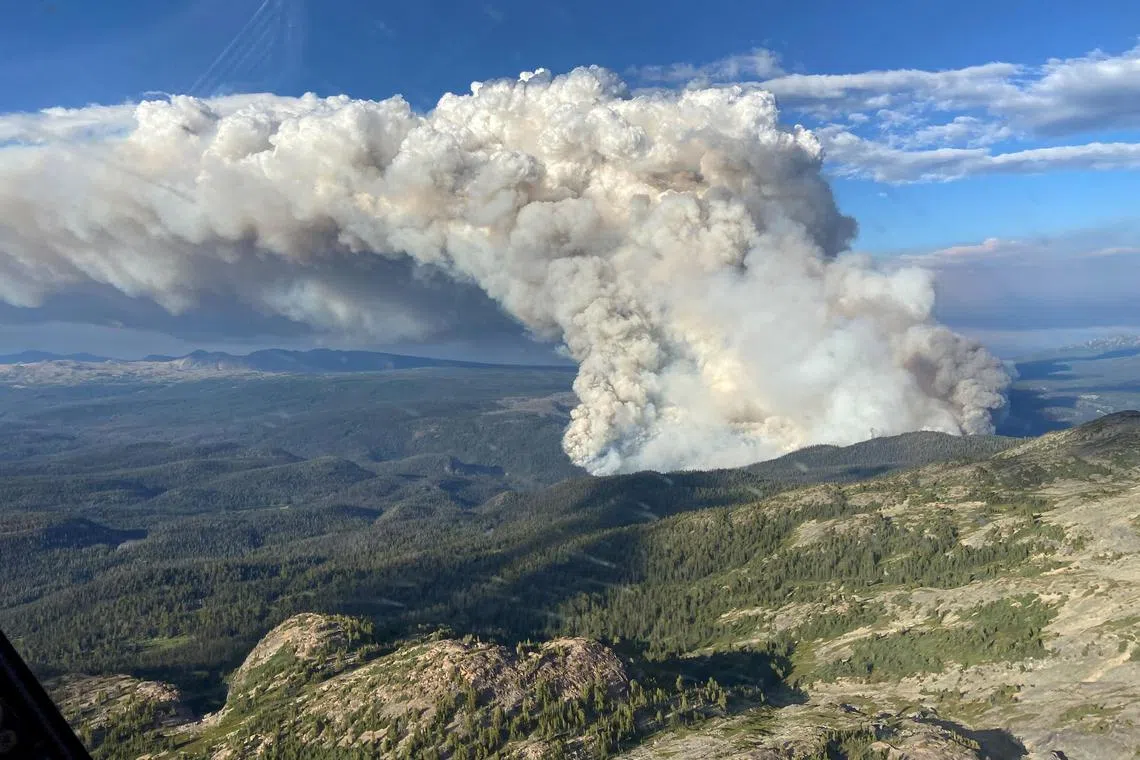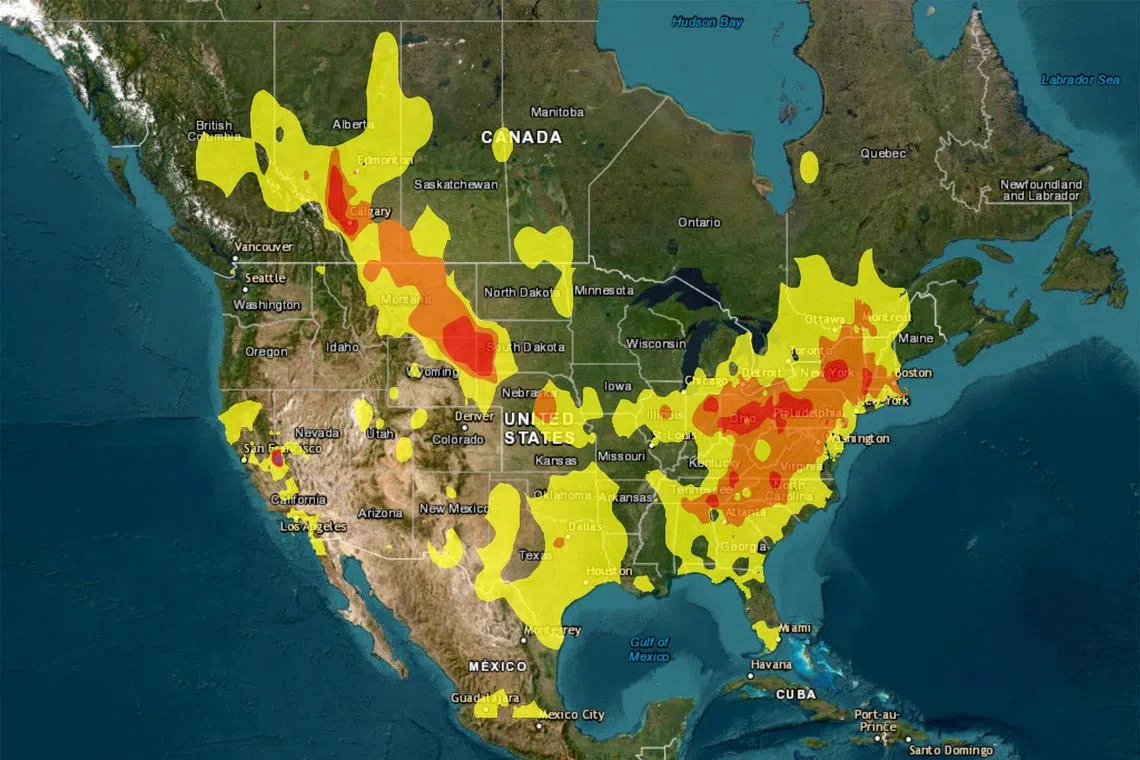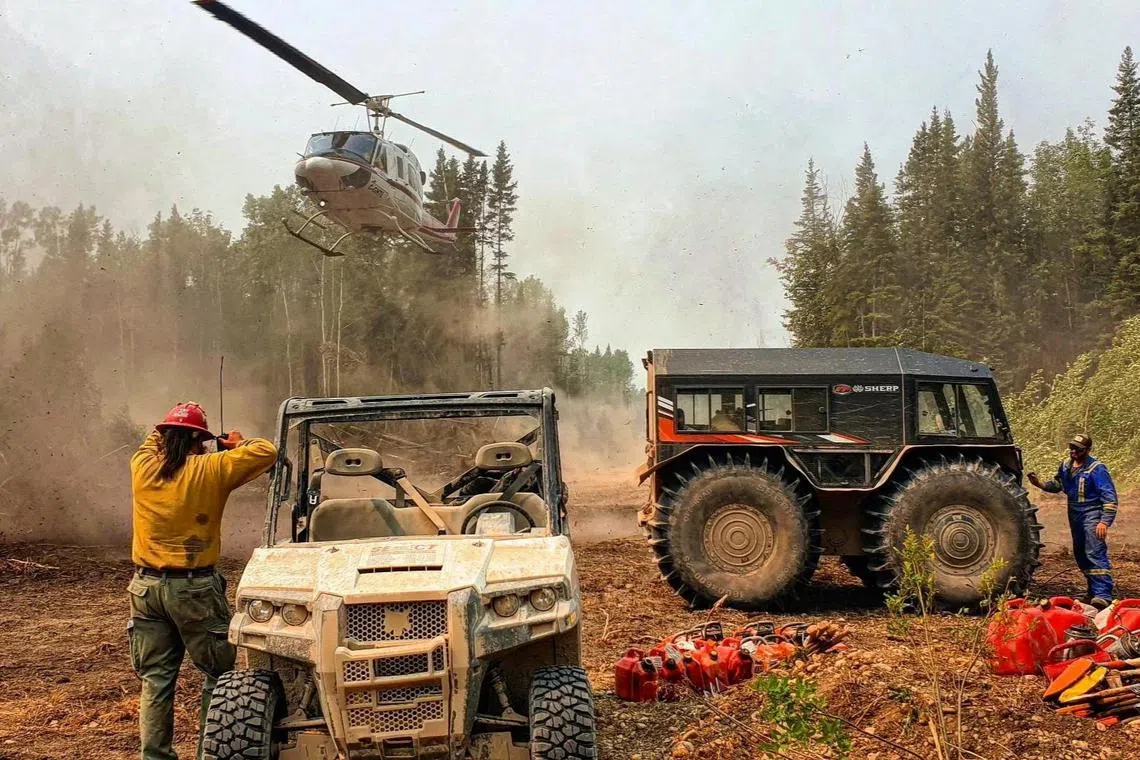Smoke pollution from Canadian wildfires blankets US cities, again
Sign up now: Get ST's newsletters delivered to your inbox

Smoke rising from the Young Creek wildfire in Tweedsmuir Provincial Park, British Columbia, Canada, on July 16.
PHOTO: REUTERS
Follow topic:
WASHINGTON - Smoke from wildfires in western Canada drifted across the Midwest and the north-east of the United States on Monday, blotting out blue sky and sun and blanketing dozens of cities with unhealthy air that triggered warnings to limit time spent outdoors.
It was the second time in less than a month
In June, heavy smoke from Quebec wafted into the East Coast, and blew from New York City,
This week, as nearly 900 wildfires burned across Canada, the smoke came from fires in the western part of the country, billowing into its southern neighbour across a wide trail.
By 3pm Eastern time, about 73 million people in 29 states were affected by the shifting, migrating smoke, according to estimates based on information from the US National Oceanic and Atmospheric Administration and LandScan, a population database.
“Unfortunately, the wildfire smoke will begin to make a return to the region to start the new week,” according to the National Weather Service in the Philadelphia area.
Air quality alerts, ranging from moderate to very unhealthy, were issued by government agencies from Montana to the Dakotas and parts of other states, including Nebraska, Alabama, Tennessee, Ohio, North Carolina and along the north-east.
Residents were advised to take precautions, from limiting outdoor activities to covering up with masks.
In Chicago, where the air quality deteriorated across the weekend, Mayor Brandon Johnson warned children, older residents and those with heart or lung disease to limit outdoor activity.
“We are acutely aware that the recent weather events prominently impacting our city this summer are the direct result of the climate crisis,” he said.
Governor Kathy Hochul of New York on Sunday issued air quality health advisories for Monday.
The air quality in parts of upstate New York was expected to reach unhealthy levels for all residents, while conditions in the Lower Hudson Valley, New York City and Long Island were expected to be unhealthy only for sensitive groups.
Air quality across the region was worsening by 4pm on Monday, with both the city and areas north of it clocking 149 on the air quality index.
“New Yorkers should once again prepare for smoke from the wildfires in western Canada to impact our state’s air quality this week,” Ms Hochul said in a statement, adding that officials were activating emergency notifications on roads and public transit systems and making sure that masks were available for distribution in counties across the state.

A map of North America shows concentrations of particulate matter (PM2.5), the main pollutant in wildfire smoke, as depicted on the airnow.gov site.
PHOTO: REUTERS
The air quality index (AQI) in Rochester started at 141 early on Monday, while Buffalo’s was at 116, but those readings were improving in both cities by late afternoon.
New York City officials said that conditions, which are considered unhealthy for sensitive groups, could persist for the initial part of the week.
The index runs from 0 to 500; the higher the number, the greater the level of air pollution.
An AQI of 201 or more is considered very unhealthy.
So far, the air quality warnings were not as bad as they were in early June, when there were readings above 400 on the East Coast, signalling a hazardous level.
But by 10am Eastern time on Monday, cities across the Midwest were reporting some of the worst air quality in the country, according to the Environmental Protection Agency.
Billings, Montana, and Fort Wayne, Indiana, had an AQI of 161, while the Cleveland area was at 157. Conditions continued to improve throughout the afternoon.
The forecast is expected to cause “unhealthy for all” conditions in the areas closest to the Canadian border, according to AirNow, a website run by the EPA, which oversees air quality across the United States.
The Ohio Environmental Protection Agency said its advisory was in effect till Monday.
In the south-western region of the state, residents were told to limit use of their vehicles, to refrain from mowing lawns and to avoid burning firewood and yard waste.

Firefighters, heavy equipment and aircraft create and strengthen control lines of the Bassett wildfire complex near Paddle Prairie Metis Settlement, Alberta, Canada.
PHOTO: REUTERS
Local officials also advised residents to limit outdoor activity or using their cars, and to wear masks.
The message was repeated from Buffalo – where Mayor Byron Brown told residents to take precautions – to Chicago, where an air quality alert was in effect till Sunday night.
In Pennsylvania, where the Department of Environmental Protection issued a statewide “code orange” alert, officials suggested residents and businesses help by limiting burning of leaves, trash and other materials, and avoiding the use of gas-powered lawn and garden equipment.
Wildfire smoke from Canada is forecast to linger till Tuesday, propelled by north-westerly winds, the weather service said.
Early in June, the level of particulate matter in the air from smoke became so unhealthy that many US cities set records.
At points, it was hazardous to breathe, everywhere from Minnesota and Indiana to sections of the mid-Atlantic and the South.
Visibility decreased to startling degrees in cities, including New York, Toronto and Cincinnati.
In some places, smoke from the fires blanketed the sky in an orange haze. That smoke could be traced to wildfires burning in Quebec. NYTIMES

